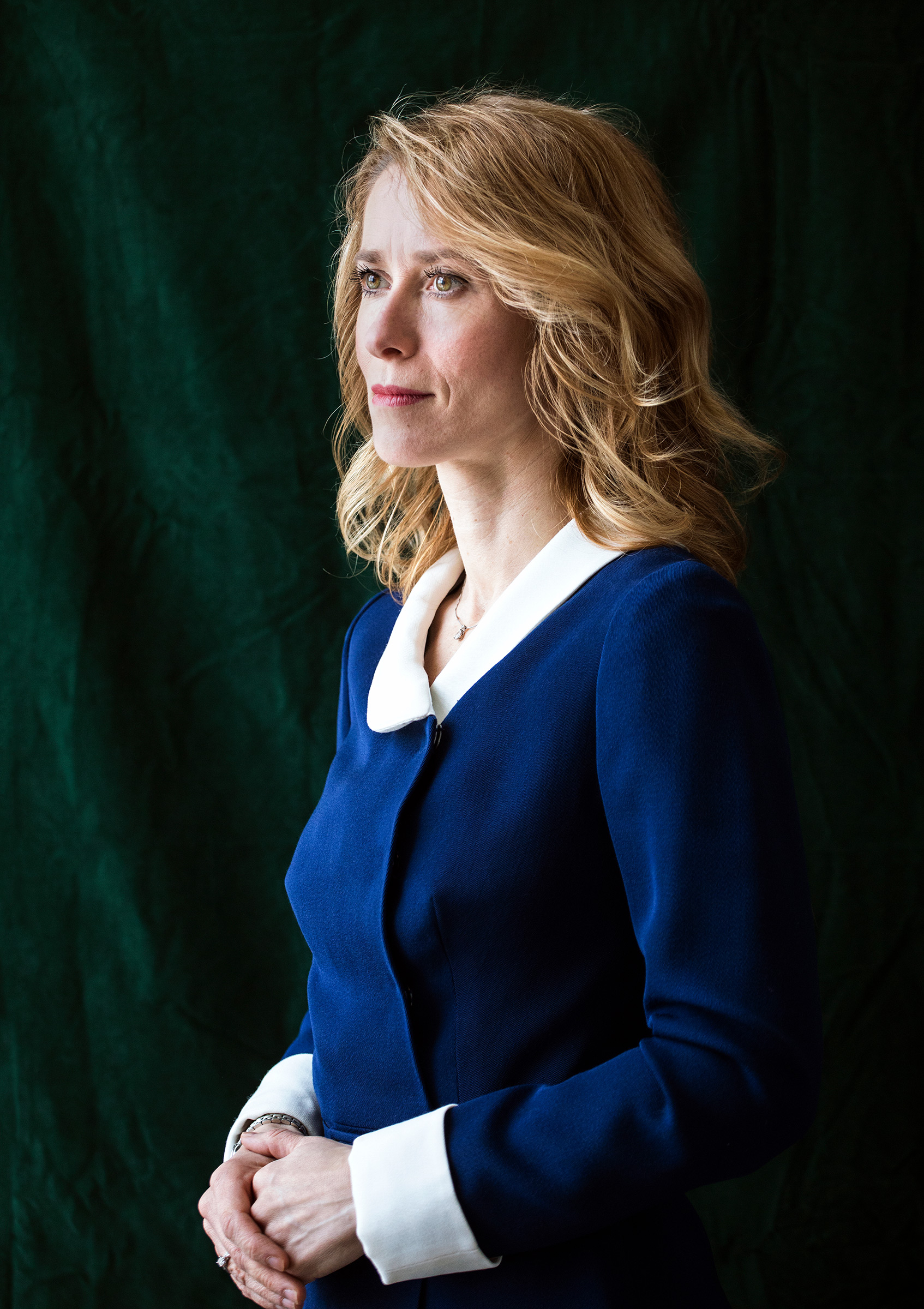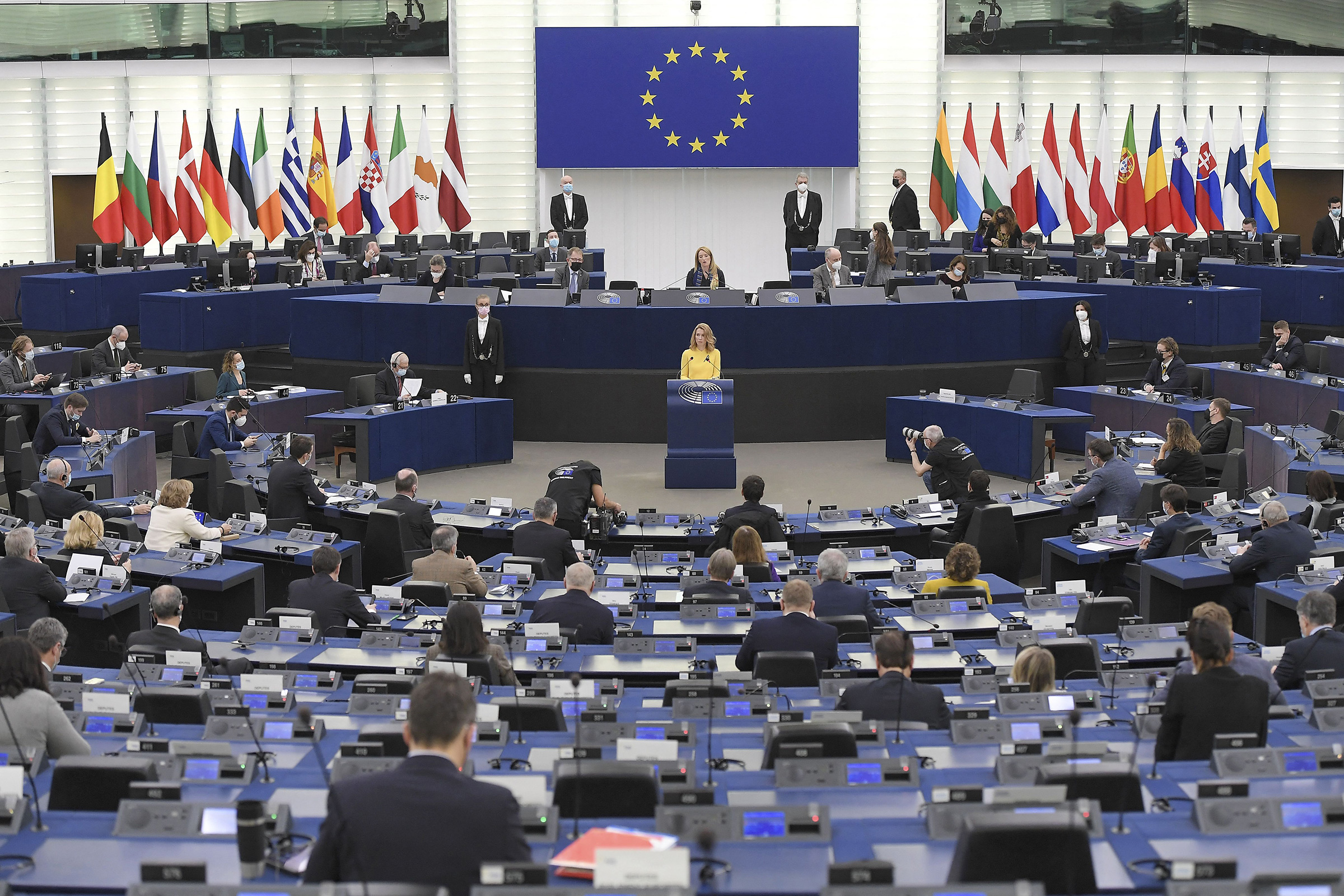
Kaja Kallas has clear memories of the Soviet occupation. She was a teenager when Estonia became independent, and she remembers growing up before that with empty shop shelves, a passport that would not allow her to travel to countries outside the Eastern bloc, and a chilling atmosphere that kept people from speaking freely outside their homes. She also remembers the stories about the harsher deprivations—deportations, imprisonment— that her parents and grandparents faced. So now that Kallas is Estonia’s Prime Minister, it makes sense that she has become one of the most vocal advocates for taking an unyielding stance against Putin.
“If Putin wins, or if he even has the view that he has won this war, his appetite will only grow,” Kallas, 44, said in late March, sitting in the elegant neoclassical building—its salons lined with paintings of Estonian patriots—that serves as the seat of government. “And that means he will consider other countries. That’s why we have to do everything we can to stop him now.”
Like other countries in the region, Estonia has had painful experiences with Russian oppression. Occupied by the Soviet Union in the 1940s, the country’s farms were forcibly collectivized and tens of thousands of its citizens deported to Siberia. It was not until 1991, when the USSR was collapsing, that the country regained its independence. Quickly reverting to democracy, Estonia joined the European Union in 2004, and put a forward-looking emphasis on digitalization—all of its public services and much of its business is conducted online. It has since become one of the fastest-growing economies in Europe. But it has never relinquished its mistrust of its powerful neighbor to the east, with whom it shares nearly 200 miles of border.
Read More: ‘Everybody’s Waiting for Putin to Die.’ A Russian Businessman on the Hopes for His Homeland
Although allies like Poland and Hungary were once in the Soviet sphere of influence, the Baltic states are the only NATO members that were formally incorporated into the USSR. Coupled with their tiny size and close proximity to Russia, that history has made some in the region feel especially vulnerable–a sense that was heightened in 2007, when, in the midst of a disagreement with Russia about the relocation of a Soviet-era monument, Estonia’s parliament, banks, and other major institutions were the victim of a massive cyberattack whose sophistication suggested to some experts that it was state-sponsored. NATO responded by creating a cyber-defense center in the Estonian capital of Tallinn.
The vulnerability also helps explain why the region identifies so closely with its defensive alliance. “I’m asked many times if Estonia or the Baltics are next,” the Prime Minister says. “But I always say that’s the wrong question. The right question is: is NATO next? And what I’ve tried to explain within NATO is that it is much cheaper to defend us in the first place than liberate us after we’re attacked.”
Although she hesitates to point fingers, Kallas admits that among the leaders of formerly occupied countries, the Russian invasion of Ukraine has triggered a certain sense of ‘we told you so.’ Her father was foreign minister when Estonia began negotiations to join NATO, and she recalls that at a time when the Soviet Union had just collapsed, the petition raised a lot of questions. “He was frequently asked, ‘Why do you need this? Russia does not pose a threat anymore,’” Kallas recalls. “Well, we knew our neighbor then, and we know our neighbor now.”
Since the Russian invasion, Kallas says Western allies have come closer to the Estonian point of view. “Before there were many who were watching this through the lens of democratic world, ” she says. “But what I was saying then, and what I think is clear now, is that [Putin] is a dictator. He doesn’t care for people’s opinion. He doesn’t care that he’s hurting his own country.”
Guided by that perspective on the Russian president, Kallas has argued from the war’s beginning for NATO to evolve from being what she calls a “forward presence” in the region to “forward defense,” with more boots on the ground and more fighter jets and ships actively patrolling Europe’s skies and seas. Her thinking is based less on any specific threat to Estonia—Kallas says there has not been any increase in Russian aggression toward the country—than on a deeply held belief, again informed by history, that it is only a robust defense on the alliance’s eastern edge that will contain Putin. “It’s easy to break one finger,” says Kallas. “But it’s hard to break a fist. A fist is much stronger in a fight.”
Read More: Inside the Historic Mission to Provide Aid and Arms to Ukraine
It was Russia’s illegal annexation of Crimea in 2014 that prompted NATO to deploy combat troops to the Baltics for the first time in 2017. Overseen by Canada, Germany, and the U.K., respectively, this “enhanced forward presence” in Latvia, Lithuania, and Estonia consisted of roughly 1,000 troops each. Since the Feb. 24 invasion of Ukraine, that number has grown (there are currently 1,700 NATO troops in Estonia) and the alliance’s “forward defense” strengthened with U.S. fighter jets. At its emergency summit in Brussels on March 24, NATO decided to reinforce its eastern border even more, announcing that, among other measures, it would be deploying four battle groups to Eastern Europe.
But if Kallas is gratified by collective increases, she isn’t easing up on the resources Estonia is devoting to its self defense. On March 24, the country increased its defense budget to 2.5% of GDP (from an already relatively high 2.3%), and she would like to see other countries go further not only in their own defense budgets, but in their aid to Ukraine as well. “We are a country of 1.3 million people,” she says, noting that Estonia has donated 2,000 tons of military and humanitarian aid since the war’s outbreak. “Believe me, the big countries could do more to help Ukraine.”

And although she was pleased with both the strength and the speed with which Europe applied economic sanctions on Russia, she’d like to see more there too. That means petroleum. “If half of Russia’s budget comes from the sale of gas and oil, then this is how Putin funds his war machine. We have to take those means away.”
Precisely because it did not want to depend on Russia for energy security, Estonia has drastically cut its imports of oil and gas in the last decade, relying instead on a mix of renewables and its own decidedly ungreen mining of shale oil. But Kallas recognizes that other countries may not be able to pull the plug on Russian petroleum so easily. As a result, she has come up with a novel proposal: to create an escrow account into which European payments for Russian gas and oil will be fed, and which can then be used to rebuild Ukraine.
“So we pay, and it is Russia’s money, but we will keep some of it in that escrow account so that when the time comes, we can give it to Ukraine, because Russia is in debt to them,” she says. “This way, Putin will get the idea that every building he bombs, every road that is destroyed or bridge that is damaged, he will pay for.”
Read More: Europe’s Green Energy Plans Are Threatened by the Need to Wean Itself Off Russian Gas
Kallas is not too concerned that such a plan would provoke Putin into cutting off the pipeline.”We’re 30 days in to the war; if he was going to do that, he would have already done it,” she says—and she also rejects some of her colleagues’ claim that she is getting ahead of herself. “Some of the prime ministers said we are already talking about reparations while the war is going on,” she says. “That is true. But I think we have to think two steps ahead. And the signal this would give Russia is: We are not paying for this. You will pay for this because you have caused the damage.”
That devastation not only convinces her that everything must be done to help Ukraine now, but also reminds her of her own country’s past. “Every family in Estonia has a history of how they suffered during the Soviet times, due to the deportations, to the killings, to the shelling of towns. So when you see that in 2022 in Mariupol they’re deporting people from their homes,” she says, “it just brings all the very painful memories back of something that you thought would never again be possible.”
In Kallas’s case that includes the story of her own family, which was deported to Siberia in a freezing 3-week journey by cattle car. Her mother was just 6 months old at the time, and Kallas’ voice fills with emotion as she recounts the hardships her grandmother and great-grandmother faced when Russian soldiers appeared at their door and told them they had to leave immediately. “What do you take?” Kallas says, as if reliving the moment. “What is really important?” Unaware of where they were being sent, her grandmother asked one of the soldiers what they should bring. Looking around the room, the soldier pointed to the Singer sewing machine her grandmother kept in the corner. “It saved them,” Kallas says now. “Because they had something they could earn a living with.”
Read More: Meet the Lithuanian ‘Elves’ Fighting Russian Disinformation
For better or worse, Estonia’s younger generation doesn’t carry that same kind of emotional baggage. “In these last 30 years, we’ve become this boring Northern European country where freedom is taken for granted, and our young people don’t live in fear,” Kallas says with a small smile. “That’s great, and it means we’ve done something right. But I’ve always thought that I’m of the lucky generation that was born in a country that wasn’t free, because it’s made me really grateful that we are free now.”
Still, as a tiny country with a vivid memory of the violence committed against it, she believes Estonians, who have already welcomed 25,000 refugees, have a clear-eyed view of what Ukraine is suffering. “If you go around to certain European countries you see these monuments to big war heroes—but they’re heroes who conquered other countries. Whereas for us, war is something that could never be positive. War means utter devastation.”
When she has the chance, she tries to impart that historical lesson to younger Estonians. Visiting a classroom, she’ll ask the children to draw the nicest day they can imagine, a request that is usually met with colorful pictures of sunshine, flowers, family members, beloved pets. When she asks them what it would look like if a war came, most of the children respond by taking black markers and scribbling violently across the page. “After that, you say, ‘OK, now turn the war into peace again,’” Kallas says. “They see that it’s impossible, because they’ve destroyed the previous picture. So now they understand: This is what war really means.”
More Must-Reads from TIME
- Where Trump 2.0 Will Differ From 1.0
- How Elon Musk Became a Kingmaker
- The Power—And Limits—of Peer Support
- The 100 Must-Read Books of 2024
- Column: If Optimism Feels Ridiculous Now, Try Hope
- The Future of Climate Action Is Trade Policy
- FX’s Say Nothing Is the Must-Watch Political Thriller of 2024
- Merle Bombardieri Is Helping People Make the Baby Decision
Contact us at [email protected]